
Enemion occidentale is a species of flowering plant in the buttercup family known by the common name western false rue anemone. It is endemic to California where it is a resident of forest, woodland, and chaparral habitats in many of the mountain ranges. This is a small perennial herb producing one or more erect, unbranched stems growing to maximum heights near 25 centimeters. Leaves appear toward the top of the smooth, naked stems. Each green cloverlike leaf is divided into usually three irregular lobes. The solitary flowers are petite with white to very light lavender petallike sepals and no petals. At the center are white stamens with yellow anthers and white styles with yellow stigmas.

Eucrypta chrysanthemifolia is a species of flowering plant in the waterleaf family known by the common name spotted hideseed.

Collinsia concolor is a species of flowering plant in the plantain family known by the common name Chinese houses.
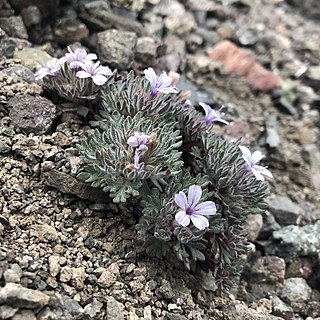
Collomia larsenii is a species of flowering plant in the phlox family known by the common name talus collomia. It is native to the Olympic Mountains of Washington and the Cascade Range from Washington to northern California, where it grows in high exposed mountainside talus. It is a perennial herb forming a clump in the volcanic rocks. The branching stem is covered in fleshy, glandular, hairy leaves, each divided into many lobes. The inflorescence is a cluster of 6 to 9 tubular purple flowers, each with a face up to 1.5 centimeters wide.
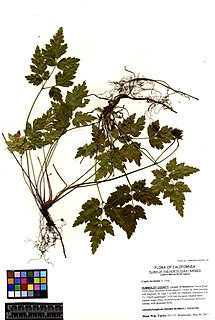
Coptis laciniata is a species of flowering plant in the buttercup family known by the common name Oregon goldthread. It is native to Washington, Oregon, and northern California on the west coast of the United States, where it grows in wet habitat in the understory of mountain and coastal coniferous forests. It is a small perennial herb creeping on a yellow stolon through other vegetation and leaf litter. There are a few leaves on its short stem which are divided into leaflets subdivided into several toothed lobes. The stemlike inflorescence arises up to 19 centimeters tall from the stem at ground level. Each flower is an array of thin, threadlike petals. Six to 12 fruits arise on short stalks, arranged in a ring. The fruits are shiny, hairless follicles, each roughly a centimeter long.

Gilia leptantha is a species of flowering plant in the phlox family known by the common name fineflower gilia.

Lithophragma affine is a species of flowering plant in the saxifrage family known by the common name San Francisco woodland star. It is native to the coast of western North America from Oregon to Baja California, where it grows in open habitat on mountain slopes, hills, and canyonsides. It is a rhizomatous perennial herb growing erect or leaning with a tall naked flowering stem. The leaves are located on the lower part of the stem, each divided into sharp-pointed lobes. The stem bears up to 15 widely spaced flowers, each in a cuplike calyx of red or green sepals. The five petals are bright white, up to 1.3 centimeters long, and divided into three toothlike lobes at the tips.
Lithophragma bolanderi is a species of flowering plant in the saxifrage family known by the common name Bolander's woodland star. It is endemic to California, where it is known from several mountain ranges, including the North Coast Ranges, the foothills of the Sierra Nevada, and the San Gabriel Mountains. It grows in many types of open habitat. It is a rhizomatous perennial herb growing erect or leaning with a tall naked flowering stem. The leaves are located on the lower part of the stem, each divided into rounded lobes. The stem bears up to 25 flowers, each in a cuplike calyx of red or green sepals. The five petals are white, under one centimeter long, and toothed or smooth along the edges.
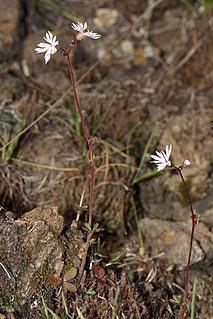
Lithophragma glabrum is a slender perennial western North American mountain plant in the Saxifrage family (Saxifragaceae), known by the common names bulbous woodland star, bulbiferous prairie-star, smooth woodland star, and smooth rockstar.
Lithophragma heterophyllum is a species of flowering plant in the saxifrage family known by the common name hillside woodland star. It is native to the coastal mountain ranges of California, where it can generally be found in shady habitat. It is a rhizomatous perennial herb growing erect or leaning with a slender naked flowering stem. The leaves are located on the lower part of the stem, each divided into rounded lobes. The stem bears 3 to 12 flowers, each in a cuplike calyx of red or green sepals. The five petals are white, up to 1.2 centimeters long, and usually divided into about three pointed lobes.

Lithophragma parviflorum is a species of flowering plant in the saxifrage family known by the common name smallflower woodland star. It is native to much of western North America from British Columbia to California to South Dakota and Nebraska, where it grows in several types of open habitat. It is a rhizomatous perennial herb growing erect or leaning with a naked flowering stem. The leaves are mainly located low on the stem, each cut into three lobes or divided into three lobed leaflets. The stem bears up to 14 flowers, each in a cuplike calyx of red or green sepals. The five petals are bright white, up to 1.6 centimeters long, and usually divided into three toothlike lobes.

Lithophragma tenellum is a species of flowering plant in the saxifrage family known by the common name slender woodland star.
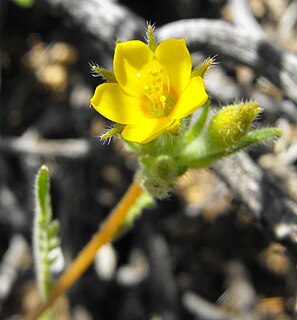
Mentzelia albicaulis is a species of flowering plants in the family Loasaceae known by the common names whitestem blazingstar, white-stemmed stickleaf, and small flowered blazing star. It is native to much of western North America, where it grows in mountain, desert, and plateau habitat.

Erythranthe bicolor, the yellow and white monkeyflower, is a species of flowering plant in the lopseed family (Phrymaceae). It is endemic to California, United States. It was formerly known as Mimulus bicolor.

Grevillea acropogon is a species of flowering plant in the family Proteaceae and is endemic to a restricted part of southwestern Western Australia. It is a prostrate to erect shrub with pinnatisect leaves with five to seven sharply-pointed lobes, and red flowers.
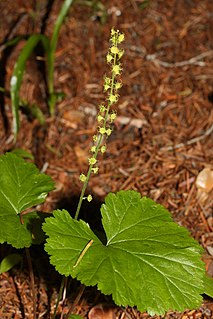
Mitella breweri is a species of flowering plant in the saxifrage family known by the common names Brewer's mitrewort and Brewer's bishop's cap. It is native to western North America from British Columbia to central California and Nevada, where it grows in moist meadows, woods, and mountain forests. It is a rhizomatous perennial herb growing up to about 30 or 40 centimeters tall. Most of the leaves occur around the base of the stem. They have rounded blades several centimeters wide and edges divided into dull toothed lobes. The erect inflorescence bears several flowers, sometimes over 50, usually along one side of the stem. The distinctive flower is saucer-shaped with five greenish petals which are divided into narrow, whiskerlike lobes.

Nemophila heterophylla is a species of flowering plant in the borage family known by the common name small baby blue eyes.

Phacelia vallis-mortae is a species of flowering plant in the borage family, Boraginaceae, known by the common name Death Valley phacelia. It is native to the southwestern United States, where it grows in deserts such as Death Valley, and mountain, plateau, and valley scrub habitat.

Polemonium chartaceum is a rare species of flowering plant in the phlox family known by the common names Mason's Jacob's-ladder and Mason's sky pilot. It is native to California, where it has a disjunct distribution. It occurs in the Klamath Mountains as well as the ranges east of the Sierra Nevada, including the White Mountains, where its distribution extends just into Nevada. It is a plant of high elevations, growing in exposed, rocky mountain slope habitat such as talus and alpine fellfields.
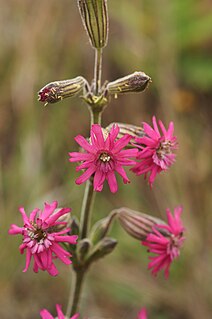
Silene scouleri is a species of flowering plant in the family Caryophyllaceae known by the common names simple campion and Scouler's catchfly.

















